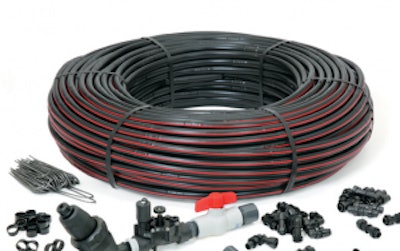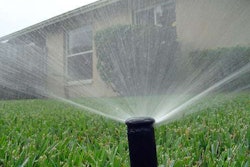
Drip irrigation (also known as micro-irrigation or low-volume irrigation) has a lot going for it. It is 90-percent efficient (compared with 50 to 60 percent for spray heads and rotors). And proponents say drip-irrigation systems are less expensive – and easier – to install and expand than higher-volume spray systems. Because drip-irrigation systems apply water precisely at the root system, plants have less disease and stronger roots, and the system can be easily changed as the plants’ needs change. Commercial installers appreciate the fact that drip systems reduce their liability risks (because there is no overspray or runoff), comply with water restrictions and regulations, and can be completely buried to reduce vandalism.
Because drip-irrigation systems apply water precisely at the root system, plants have less disease and stronger roots
Chris Abbott, landscape specification manager for Toro’s micro-irrigation products, says that drip irrigation can be used for any irrigation situation, but says the most common are:
- Narrow or curvilinear planting areas
- Street medians and frontages
- Parking islands
- Slopes, hedgerows, and planted retaining walls
- Overspray sensitive areas (borders next to sensitive hardscapes and windows)
- Windy areas
- Landscaped areas where mixed plantings have varied water requirements
- Berm plantings
- Turf applications using subsurface drip irrigation
Avoid these common mistakes
The mechanics of installing drip irrigation are pretty simple, but professional landscapers have an advantage over do-it-yourselfers with the knowledge of how to fine-tune the system to operate at peak efficiency and how to avoid the most common pitfalls of drip irrigation installations.
One of the most common mistakes made in installing drip systems is not giving enough thought to filters and pressure regulators. “In landscape drip irrigation systems, a 150 mesh filter is usually the minimum requirement to remove debris from the water that could clog the emission devices,” Abbott says. “Pressure regulators must be installed to protect downstream components from excessive pressures. Drip systems operating pressures are in the 10-30 psi range. Spray heads and rotors operate above 30 psi and should not be installed on the same irrigation zone.”
“Most drip irrigation systems require 30 psi to operate successfully and at least 10 psi at the most distal end for flushing,” says Jeffrey Knight, educator and national trainer for Ewing Irrigation. “Since the flow rate in drip irrigation systems is generally low, there is very little pressure loss; pressure regulators may need to be installed to avoid excessive pressure (45 psi for most drip systems).
In theory, drip systems are far more efficient than overhead systems, but intelligent design still matters. Drip irrigation flow rates are measured in GPH (gallons per hour) vs. GPM (gallons per minute) for sprays and rotors, which means drip systems need to be cycled for longer run times to allow for water penetration to the root zone – think hours, not minutes.
But over-correction is common, too. “One of the most common mistakes occurs in the mathematical portion of the design consideration. One error in your calculations could mean the difference between healthy plants or dead plants, so always check – and recheck – your calculations carefully. Many landscape contractors don’t know how to calculate proper run times and therefore tend to over-water,” Knight says.
One of the inherent advantages of drip systems is their flexibility to be expanded or rerouted as needs change. So give some thought to future expansion in the initial design phase. As a tree’s growing canopy expands, for example, emitters will need to be moved away from the root ball to encourage a healthy root system.
“A frequent mistake commonly found in unsuccessful drip installations is the failure to install multiple drippers on each plant,” Knight says. “Positioning more than one emitter per plant will safeguard the plant from the possibility of being cut off from a single water source.”
Improper maintenance the leading cause of drip irrigation failure
Drip systems are often run under the mulch but above the soil, with sod staples about every 18 inches. Aesthetically, this is an advantage, but not only is the system out of sight; its problems are, too. Remember a broken sprinkler head may run a river of water into the street immediately alerting you to the problem. But with a clogged filter or gopher-chewed drip line, the problem might not be obvious until plants start to die or garden ornaments start sinking into the ground beneath them.
“Improper maintenance is a leading cause of drip irrigation system malfunction,” Knight says. “A drip system must be flushed out periodically. The flow rate is often so low in drip systems that sediment can settle to the bottom of the line. The flush valve should be opened to increase the velocity enough to stir up the sediment, and remove it from the line.”
Offer regular drip systems maintenance with your maintenance contracts. This should include checking for leaks and breaks in the system, cleaning filters on a regular basis, and adjusting run cycles to meet seasonality and plant water requirements, and will help keep your client’s systems running efficiently.







